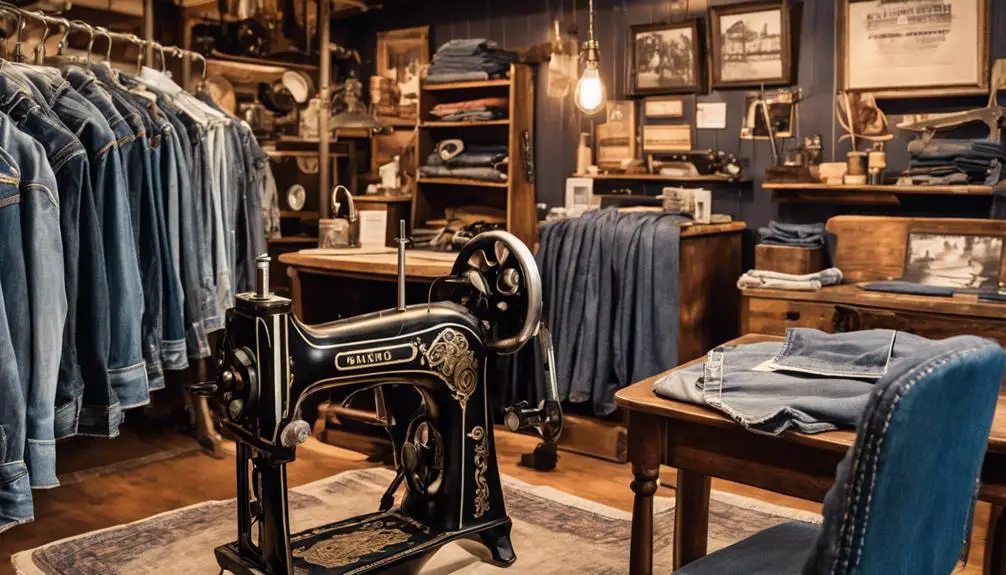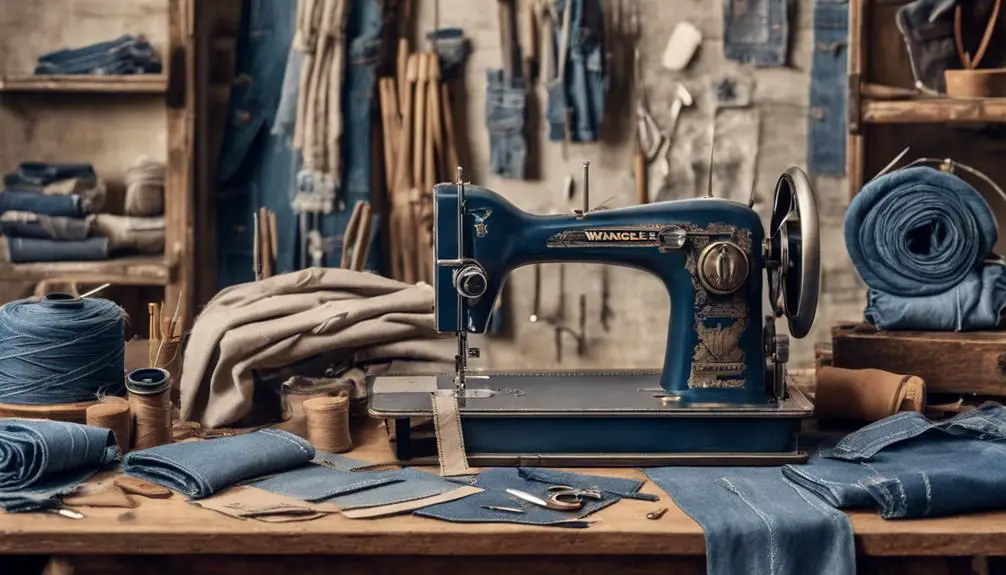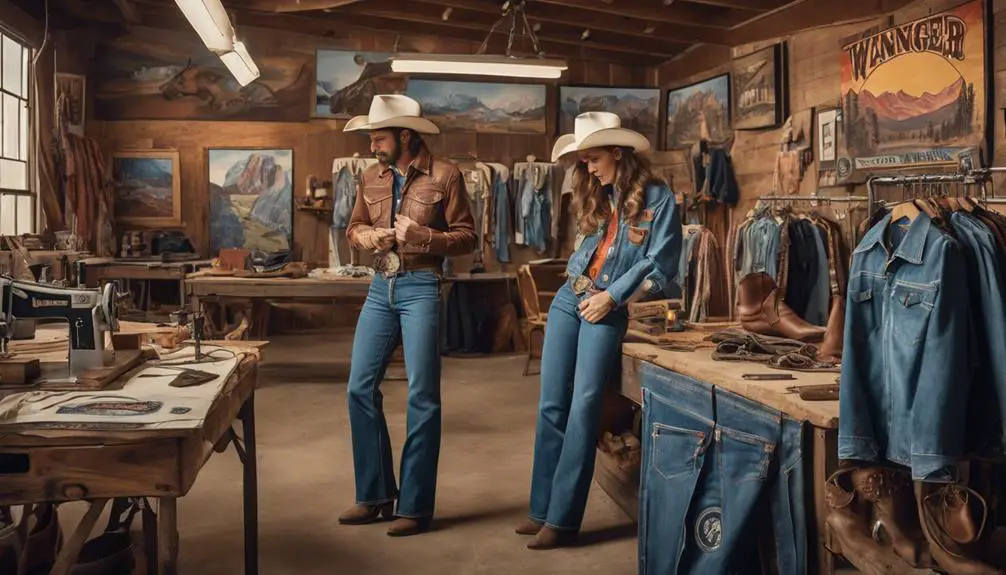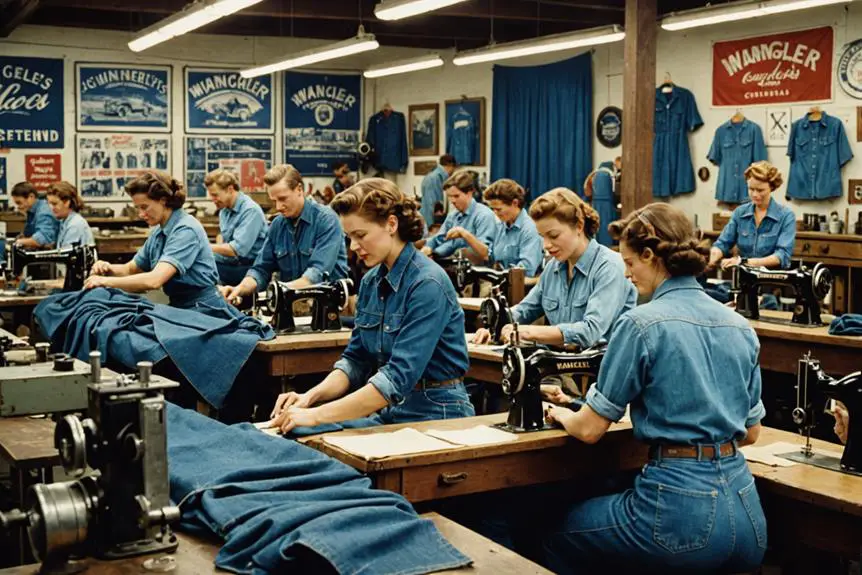Wrangler was founded in 1947 as a brand under the Blue Bell Overall Company, which dates back to 1904. This emergence followed Blue Bell's acquisition of the Casey Jones Work-Clothes Company, securing the Wrangler name. Rodeo Ben designed the first Wrangler jeans specifically for cowboys and rodeo participants, introducing the 11MWZ model that same year. These jeans featured innovative designs aimed at rider comfort and durability, quickly gaining popularity. Wrangler's reputation grew as they expanded into the European market and became a symbol of rugged American culture, appealing to diverse consumers around the world. There's much more to discover about Wrangler's journey!
Early Beginnings of Wrangler

The story of Wrangler begins in 1947, rooted in the legacy of the Blue Bell Overall Company, which dates back to 1904. You mightn't know that Wrangler was born from the acquisition of the Casey Jones Work-Clothes Company in 1943. This acquisition included the rights to the Wrangler name, setting the stage for a new brand that would soon thrive in the world of western wear.
Designed by the talented Rodeo Ben, Wrangler jeans were crafted specifically for cowboys and rodeo participants. With an emphasis on comfort and durability, the jeans quickly became a favorite among those who needed reliable workwear. In 1947, the brand introduced its first jean model, the iconic 11MWZ. This model featured innovative elements tailored for riders, ensuring that cowboys could move freely while working or competing.
Over the years, Wrangler gained recognition for its durable and functional denim, solidifying its place in the western wear market. The ruggedness of Wrangler jeans made them popular not just among cowboys, but also with everyday consumers who valued quality and style.
As you explore Wrangler's early days, it's easy to see how the brand captured the spirit of the American West and became synonymous with tough, dependable clothing. Whether you're at a rodeo or simply enjoying the outdoors, Wrangler jeans remain a tribute to the brand's commitment to quality and craftsmanship, continuing the legacy that began over seventy years ago.
Key Acquisitions and Milestones
Building on its early successes, Wrangler achieved significant milestones that shaped its growth in the denim industry. Founded in 1943, Wrangler emerged when the Blue Bell Overall Company acquired the Casey Jones Work-Clothes Company, gaining the rights to the Wrangler brand name. This strategic move laid the foundation for the brand's future success.
Just a few years later, in 1947, Wrangler launched its first jeans, designed by the celebrated tailor Rodeo Ben, who was known for creating functional clothing for cowboys. These jeans quickly gained popularity, establishing Wrangler as a key player in the market.
In 1962, Wrangler took a bold step by expanding internationally, opening a factory in Belgium. This marked its entry into the European market, allowing Wrangler to reach a broader audience.
The brand's credibility soared even higher in 1974 when it became the official jean of the Pro Rodeo Cowboys Association, solidifying its reputation within the rodeo community and connecting its brand with the rugged lifestyle of cowboys.
The journey continued when Blue Bell merged with VF Corporation in 1986, which allowed Wrangler to strengthen its position as a leading jeans manufacturer in the U.S. market.
Each of these key acquisitions and milestones not only contributed to Wrangler's growth but also helped shape the denim industry as it's recognized today, making it an iconic name in American fashion.
Innovations in Design

Wrangler's commitment to innovation in design has played a pivotal role in its enduring success. Since the introduction of the 11MWZ jeans in 1947, the brand has focused on creating jeans that meet the unique needs of its wearers. Designed specifically for rodeo cowboys, these jeans featured felled outseams and rear pockets optimized for saddle comfort.
Significantly, the 11MWZ was crafted without rivets, showcasing Wrangler's dedication to functionality by preventing scratches on saddles.
In 1968, Wrangler took a significant step forward with the launch of the 13MWZ model, which utilized broken twill denim. This innovative fabric provided improved comfort and a softer texture compared to traditional herringbone denim, making it a favorite among users.
Wrangler didn't stop there; their innovations also included comfort pockets and strong crotch tacks that enhanced the durability and usability of their jeans.
The brand's continuous focus on design innovations culminated in the development of specialized collections, like the Ultimate Riding Jean for female riders. This particular line was thoughtfully designed to cater to specific user needs, ensuring comfort and performance during rides.
By prioritizing both comfort and durability, Wrangler has successfully created jeans that resonate with a diverse audience, from rodeo cowboys to everyday wearers.
Expansion and Global Reach
Expanding into international markets has been a game-changer for Wrangler, marking its evolution from a regional brand to a global icon. The journey began in 1962 when Wrangler opened its first European factory in Belgium. This significant step marked Wrangler's entry into the global market, setting the stage for future growth.
By the mid-1980s, Wrangler had established a strong presence in Europe, becoming synonymous with youth and American culture. The merger with VF Corporation in 1986 further solidified Wrangler's position. This partnership allowed Wrangler to thrive as a distinct entity within a larger corporate structure.
It enhanced the brand's market reach, allowing its jeans to penetrate numerous international markets more effectively. By 1996, Wrangler jeans accounted for an impressive 20% of all jeans sold in the U.S., showcasing the brand's widespread popularity and influence.
Today, Wrangler operates in 22 countries worldwide, demonstrating its commitment to maintaining a global presence. This expansion isn't just about selling jeans; it's about sharing the essence of the American western lifestyle with consumers around the globe.
As you explore Wrangler's journey, you can see how its international expansion has transformed the brand into a symbol of quality, durability, and style. Wrangler continues to embrace its roots while adapting to diverse markets, ensuring that its jeans remain a favorite for people everywhere.
Wrangler's Cultural Impact

Denim has become more than just a fabric; it's a cultural phenomenon, and Wrangler plays a pivotal role in that narrative. From its iconic W stitch on back pockets to its deep roots in cowboy culture, Wrangler represents a blend of rugged American heritage and contemporary youth culture.
Its marketing strategies have successfully immersed the brand in various cultural arenas, ensuring that Wrangler remains relevant and appealing across generations.
Here are some key aspects of Wrangler's cultural impact:
- Cowboy Culture: Wrangler embodies the spirit of the American cowboy, connecting consumers to a rugged lifestyle.
- Dale Earnhardt: Sponsoring the NASCAR legend helped Wrangler bridge the gap between motorsports and everyday American apparel culture.
- Youth Culture: Gaining significant popularity in Europe during the 1960s, Wrangler jeans became an iconic symbol of youth and rebellion.
- Promotional Campaigns: The brand emphasizes its roots through campaigns that celebrate its commitment to cowboy culture and American values.
- Cultural Significance: Wrangler's adaptability allows it to maintain a cult following across diverse demographics worldwide.
Through these elements, Wrangler has solidified its place not just as a clothing brand but as a cultural touchstone.
Its jeans tell stories of adventure, tradition, and modern identity, making the brand an enduring part of denim history. Whether you're at a rodeo or a city street, wearing Wrangler means embracing a legacy that transcends time.





I found it fascinating to learn about Wrangler’s deep roots within the Blue Bell Overall Company, dating back to 1904. The transition from the Casey Jones Work-Clothes Company to the birth of Wrangler in 1947 showcases a rich history of innovation and evolution in geometry dash lite workwear. Rodeo Ben’s emphasis on comfort and durability when designing the iconic 11MWZ model truly highlights Wrangler’s commitment to meeting the specific needs of cowboys and rodeo participants. It’s impressive how Wrangler managed to capture the essence of rugged American culture and expand its appeal globally. This journey truly reflects the brand’s authenticity and dedication to quality craftsmanship.